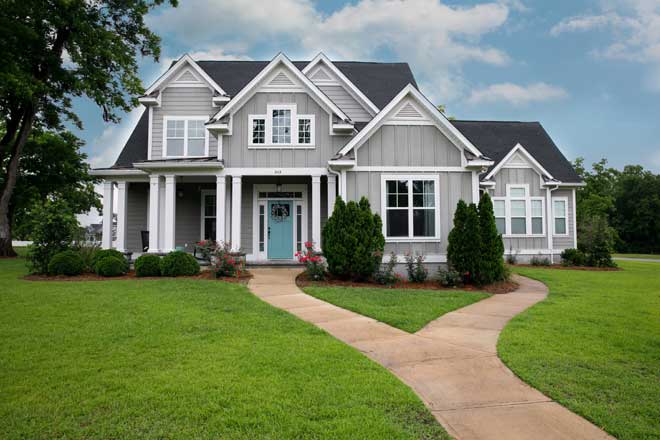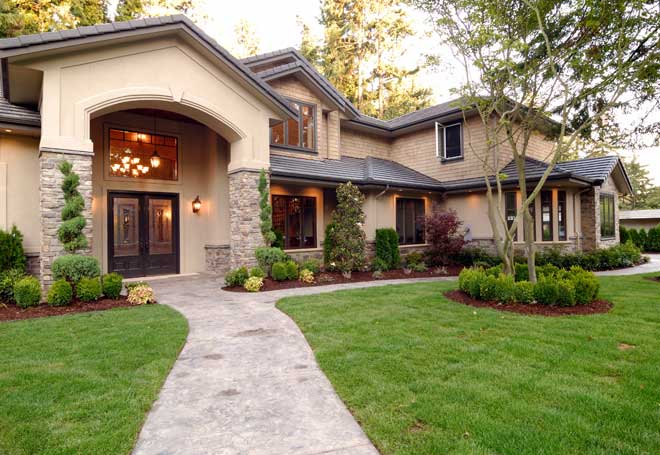Sidewalks are one of your home’s most important exterior features, contributing to utility, design, and safety. Whether you want to install a new sidewalk or keep your existing ones in top shape, this guide will teach you everything you need to know.
What Are the Three Main Sidewalk Types?
There are three different classes of sidewalks to accommodate various locations and use levels. Depending on the class, a sidewalk may need to be wider or built from sturdier materials to keep up with safety and local codes.
Primary Walkways
Primary walkways are the most frequently used sidewalks, including the sidewalks along your street and up to your front door. Sometimes, other heavily traveled walkways, like ones from a house to a detached garage, will fall into the primary class.
As a rule, these sidewalks should be wide enough for two people, about 4 feet. You should also limit them to large and sturdy materials—this prevents them from shifting and makes it easier to remove snow and weeds.
Concrete slabs and bricks are the two most popular primary walkway materials. In upscale neighborhoods, you may also see large, close-fitting flagstones embedded in concrete.

Secondary Walkways
Secondary walkways are common to have around the side of a house. They’re wide enough to support one or two people at a time and often branch off of primary sidewalks. You can build them from various materials based on the path’s function.
For example, a walkway to your garden shed can use packed gravel wide enough for a single person. If it leads to the back of the garage or goes along the side of the house, then it’ll function more like a primary walkway and needs firmer materials.
Tertiary Walkways
Tertiary walkways are the smallest and least-used. You can make them from any material primarily used for aesthetics. You may build them for gardens or places where you’re not likely to rush or carry heavy loads. Unlike other classes, they can be uneven or include gently rounded stones.
One unique feature of a tertiary walkway is its ability to use widely-spaced flagstones with ground cover like Baby’s Breath. Gravel is another common material. Sometimes, it’s held in place by bordering stones with no substructure.
Common Sidewalk Materials
Over the centuries, walkways have evolved from sand or dirt paths to use more materials. Here’s a look at some of the most common options:
- Brick: You can use bricks in various patterns, separated with mortar or fitted dry. Since they’re modular, you can replace sections easily. They’re also excellent conductors for heated walkways. However, weeds can take root between the bricks, including mortared configurations that have become cracked.
- Cement and concrete slabs: Concrete slabs are the material of choice for most roadside sidewalks. They’re durable and easy to maintain, and you can add inlays and designs while the material is still wet. However, concrete can be frustrating to repair, especially when tree roots burrow underneath and cause slabs to shift.
- Flagstone and flagstone pavers: Flagstones and flagstone pavers are cut to have a flat upper side. They come in many sizes and usually have natural edges, so they cannot easily fit together closely. Most flagstone walkways are anchored to avoid shifting, filling the gaps with gravel, sand, or dirt.
- Gravel and crushed stone: Gravel is usually a filler, but it can also make a good solo material for tertiary walkways. Weeds grow slower than on gravel than on bare ground, and the gravel is a natural water filter that reduces the risk of puddles and flooding.
- Precast concrete: Precast concrete is a close relative of brick and comes in several shapes, sizes, and designs. This allows for mosaic patterns and smoother transitions to other walks. It’s also less slippery in the wintertime.

Sometimes, walkways use unusual materials like asphalt, Baby’s Breath, mulch and wood chips, synthetic tracks, or treated wood. These materials may not be available near you. They’re often better suited for specific purposes.
Basic Sidewalk Maintenance
Every sidewalk needs some degree of care. Here are a few simple tips to keep your walks clear and functional without shortening their life spans.
Managing Tree Roots
Trees and shrubs are a wonderful addition to your landscape, but the roots can upheave concrete slabs over time. It’s dangerous to cut the roots, as they do help keep trees balanced in high winds. However, you can work around them by using one of these methods:
- Bridging: Place an elevated slab above large roots and connecting slabs that slope upward and downward for a smooth transition.
- Cut-outs: For roots that don’t cross the entire width of the walk, leave a gap filled with dirt around the root. This will reduce the width of the walk but allow you to make that section level. Don’t violate local codes by choosing a cut-out.
- Stepped bridges: Use one or two steps at each end to connect a raised section over the roots to the walkway. This method works well with most materials, but it’s less practical for curbed walks or walkways where wheeled traffic is common.
If you choose to bridge over the root, the elevated slab should have a cement or stone under-structure, which leaves enough room for further growth. Consult your local code enforcement agency to ensure such repairs are up to code.
Controlling Weeds and Overgrowth
Weeds can take root in even the smallest of sidewalk cracks. You can pull them by hand, apply chemical herbicides, or use an edger to keep them under control. A small amount of cement or mortar can also help stop new growth by patching the crack.
There is a third method that’s faster, safer, and cheaper: a saltwater spray. High saline content will kill weeds, but you shouldn’t spray too close to garden plants because the salt will absorb into the ground.
If you’re lining your sidewalk with shrubs or other tall plants, they may encroach on the path with time. Regular pruning helps, but you can also choose to add short retaining walls to control growth and prevent nearby soil from washing onto the walkway in the rain.
Winter Care
Other sidewalk problems, especially in northern areas, are snow and ice. It’s easy to shovel or blow snow off of flat, even surfaces like brick and concrete. Flagstone and gravel walkways, however, are more difficult to keep clear in the wintertime.
Putting salt and chemical deicers down is a popular way to clear snow and ice, but the salt can erode the sidewalk over time. Some formulas also contain antifreeze that may be toxic to pets and wildlife. You can buy organic deicers, but the simplest option is to apply sand or coarse grit that helps with traction.












